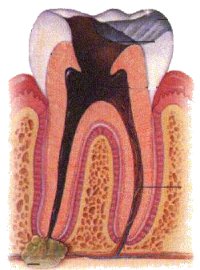Root
Canal Treatment
If your tooth's nerve
chamber becomes infected by decay, root canal
treatment is often the only way to save your
tooth.
Inside your tooth's
hard outer shell is a nourishing pulp of blood vessels, lymph vessels and
nerves. The root's canal, allow these vessels and nerves to extend to the
bone.
 Deep tooth decay,
or injury can cause serious damage and infection to the pulps nerves and
vessels. Root canal, also known as endodontic,
treatment cleans out the infected pulp chamber and canals.
Deep tooth decay,
or injury can cause serious damage and infection to the pulps nerves and
vessels. Root canal, also known as endodontic,
treatment cleans out the infected pulp chamber and canals.
Some indications
of the need for root canal treatment may be:
-
Spontaneous pain or
throbbing.
-
Pain while biting or
chewing.
-
Sensitivity to hot and
cold.
-
Severe decay or injury
that causes an abscess (infection) in the bone surrounding the tooth.
Treatment Procedure
 Step 1
After the tooth
is anesthetized, an opening is made through the crown into the pulp chamber.
Step 1
After the tooth
is anesthetized, an opening is made through the crown into the pulp chamber.
 Step 2
The lengths
of the roots' canals are determined.
Step 2
The lengths
of the roots' canals are determined.
 Step 3
Unhealthy pulp
is removed. Canals are cleaned, enlarged and shaped using progressively
larger endodontic files.
Step 3
Unhealthy pulp
is removed. Canals are cleaned, enlarged and shaped using progressively
larger endodontic files.
 Step 4
Canals are filled
and sealed. A metal post may be added for structural support or to retain
restorative materials.
Step 4
Canals are filled
and sealed. A metal post may be added for structural support or to retain
restorative materials.
 Step 5
The tooth is
sealed with a temporary filling. Usually a gold or porcelain crown adds
further protection.
Step 5
The tooth is
sealed with a temporary filling. Usually a gold or porcelain crown adds
further protection.
The material used to
fill your root canal will probably last you a lifetime, but eventually
the filling or crown may need to be replaced.
Endodontic Procedure
in a tooth with a single canal
Menu






